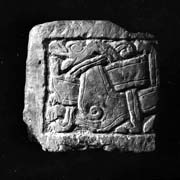Select a site alphabetically from the choices shown in the box below. Alternatively, browse sculptural examples using the Forward/Back buttons.
Chapters for this volume, along with copies of original in-text images, are available here.
Object type: Fragment of grave-cover [1]
Measurements: L. 23 cm (9 in); W. 11.5 cm (4.5 cm); D. 22.3 cm (8.75 in)
Stone type: Fine-grained, dolomitic, white to very pale brown (10YR 8/2–8/3) limestone, with small cavities; Lower Magnesian Limestone, Upper Permian; reused Roman ashlar, originally from Tadcaster area (see Fig. 5)
Plate numbers in printed volume: 327, 329-330
Corpus volume reference: Vol 3 p. 103-104
(There may be more views or larger images available for this item. Click on the thumbnail image to view.)
The top of the slab is uncarved. The decoration lies on the two vertical sides.
B: A flat perimeter moulding surrounds the end of the panel. Within the moulding is a drilled fix-point hole. The panel contains half a pattern of two interlocked profile beasts, one upside-down. The upright beast has an incised double outline. The long neck tapers from a substantial chest which has a scroll in relief immediately above the junction of the fore leg. The leg is double-outlined and has a four-toed paw. The head has an incised elliptical eye and an unfinished triple nose-fold. The lower jaw hangs open. The ear is extended into a median-incised fetter band which binds both animals.
The unfinished foot of the reversed beast lies in the mouth of the upright one. Its body has an incised double outline and median-incised tail. A fix-point hole lies on the incised contour.
E: The perimeter moulding is broad and flat, matching face A's. It also has fix-point markings. Within the panel is the head of a profile beast with double outline. The head is domed with a small, pricked ear and snub jowl. The incised eye is elliptical. The mouth is a closed slit and from it droops a frondy element. A forepaw has three toes.
The fragment is an unfinished reject. The reversed beast of face A has incomplete rear quarters and the top has been only roughly prepared.
There is every likelihood of this piece being produced by the same hand as Newgate 1 (Ills. 342–6) and the Clifford Street slab (Ills. 328, 331–2). The inclined cutting of the planes where fetters cross are common to all three. The beast-head of face B is identical with those of the beast-chain of Newgate and derives from English manuscript styles of the late ninth century. The face A beast, on the other hand, has the nose-fold and extended ear more usually associated with the Jellinge style. Like the other stones in the group, Magnesian Limestone is used. It is the work of the York Master (see Chaps. 10, 13, and Newgate 1).
The archaeological context implies a deposition date of not later than c. 960 (pers. comm. R. A. Hall). This is a much needed example of a stratified context for pre-Conquest sculpture. Such a date conforms with stylistic chronology for the animal ornament.



